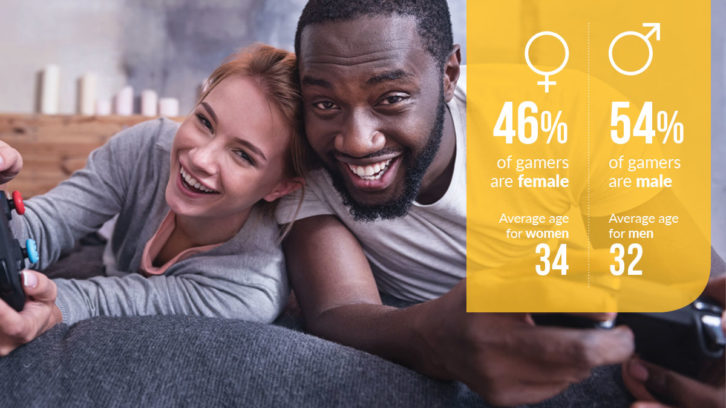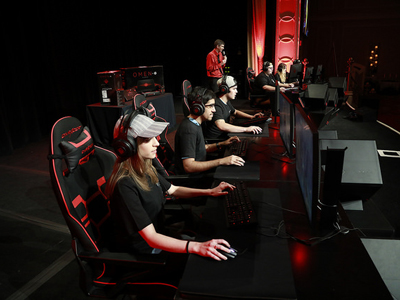
When someone mentions “gamers,” the stereotypical visual that’s conjured is of an engrossed male teenager. If you create, market or sell games and gaming gear with this male Gen Z stereotype as your avatar, not only is this image incomplete, you could be both eliminating and alienating a huge potential customer base – women.
According to a recent survey of 1,000 women in the U.S. conducted by online gaming company Arkadium and released in time for International Women’s Day on March 8, 42 percent of the respondents identified themselves as gamers.
Arkadium’s findings about female gamers jibe with the first Entertainment Software Association (ESA) “Essential Facts About the Computer and Video Game Industry” report, which found that 46 percent of all game players were women across all generations, including Gen Xers, millennials, and even boomers.
See also: WIN: Women In Nationwide And WithIt Find Synergies In Helping Women Advance Professionally
“Women are always a target for retailers in tech, but gaming companies haven’t done enough to cater directly to the segment,” says Arkadium CEO Jessica Rovello. “The untapped potential from game developers and publishers to generate strategies to increasing the overall size of the segment is massive, and we expect this change in the near future.”
And women aren’t exactly casual gamers. According to Arkadium’s survey, nearly half of the respondents (48 percent) say they play games regularly, and more than a third (34 percent) play often.
While play frequency may not differ much from men’s gaming habits, the types of games each gender plays does.
The survey says the most popular games among women are so-called “memory games” (16 percent) and “strategy games” (13 percent), while prototypical male fare such as shooting (2 percent), massive multiplayer online (1 percent), and sports games (>1 percent) were the least popular. Some game designers obviously recognize that female players want different games.
 “Candy Crush comes immediately to mind,” observes Rovello. “Females are prominently featured, and the game uses a very inclusive design language to welcome players of all stripes.”
“Candy Crush comes immediately to mind,” observes Rovello. “Females are prominently featured, and the game uses a very inclusive design language to welcome players of all stripes.”
Another major difference between male and female players is the gaming device of choice. According to ESA, 60 percent of all gamers regardless of gender play on a smartphone, 52 percent on a PC, and 49 percent on a console, which indicates that most gamers aren’t platform picky. While smartphones also are the top platform of choice for women, that preference reached just 44 percent, with only 19 percent preferring to play on a console, and a mere 14 percent on a desktop or laptop PC.
As a result of the types of games they play and where they play them, many women may not identify themselves as “gamers.”
“Mobile games are played just as much by people during their commute or looking to pass some time, just as some examples,” Rovello observes. “Although many women play these kinds of games very regularly, they might not necessarily classify themselves as a gamer despite spending 10-plus hours a week playing games.”
See also: Nowhere to Go But Up: WiCT 2020 Honorees Continue the Fight for Diversity in Tech
Women also don’t believe that the market sees or identifies them as gamers either, and if it does, that image isn’t flattering. Sixty-nine percent of Arkadium respondents agreed that “there’s a common stereotype of how a gamer is typically perceived,” and 58 percent said the gamer stereotype was negative.
But how the gaming industry sees female gamers and how women gamers see themselves are two different things, and therein lies the disconnect between how the industry currently operates and how it might be failing to attract the potentially lucrative female player market.
“Our data is clear in showing more women are identifying themselves as gamers and proud of the fact,” Rovello insists, adding “I don’t necessarily agree with the notion that by appealing to female gamers it’ll turn off male shoppers.”
All of which indicates that game designers, game hardware makers and retailers may be alienating a prime market with purely testosterone-driven content, hardware and merchandising. And appealing to female gamers creates an opportunity for some creative product creation, retail merchandising and marketing.
“They are missing the mark in how they market their games,” Rovello agrees. “Since men are perceived as their main customers, marketing strategies around new titles are often designed to ensure they win over that core audience without much thought of how to expand to these new audiences. Even with the tremendous growth and appeal of games over the last few years, this is a huge missed opportunity by gaming companies. They shouldn’t be strictly focused on keeping their piece of the market, but on how to create new games to better appeal to emerging markets such as women or older gamers.
“Games are no longer a ‘male activity’,” Rovello adds, “and the sooner companies take notice, the sooner they can generate larger communities and greater reach.”
See also: Have You Secured Your Ticket For The 2020 Wonder Women Event Yet?













